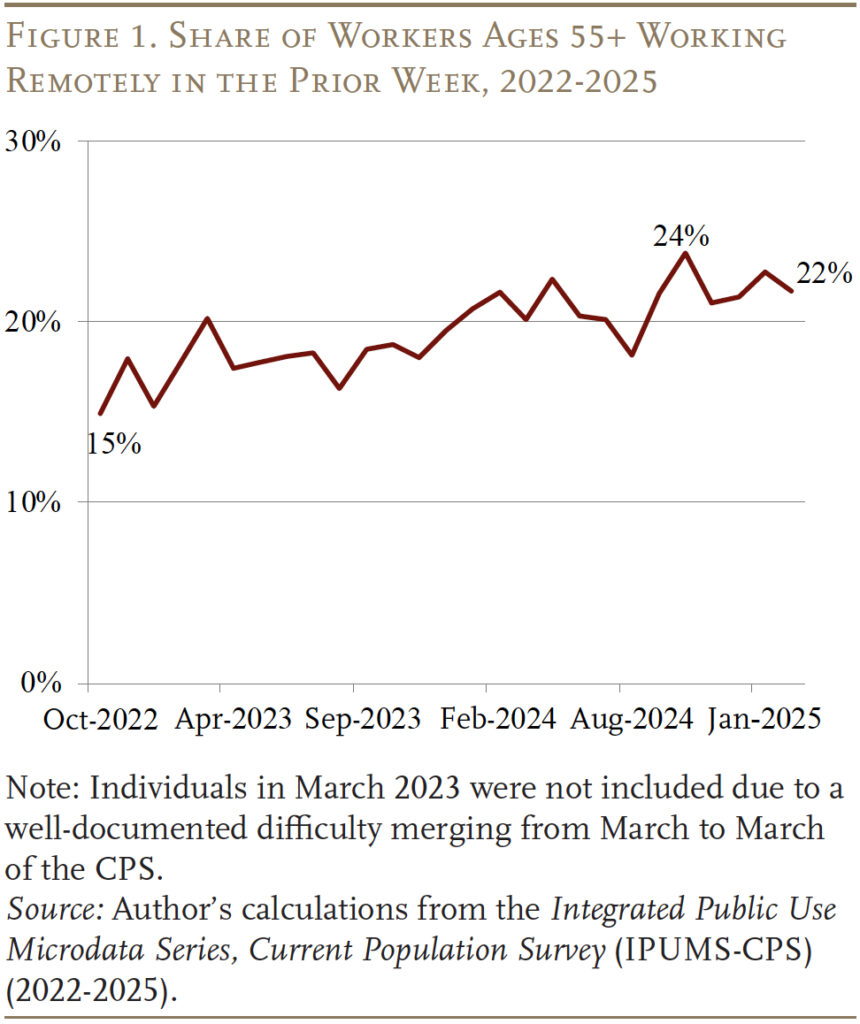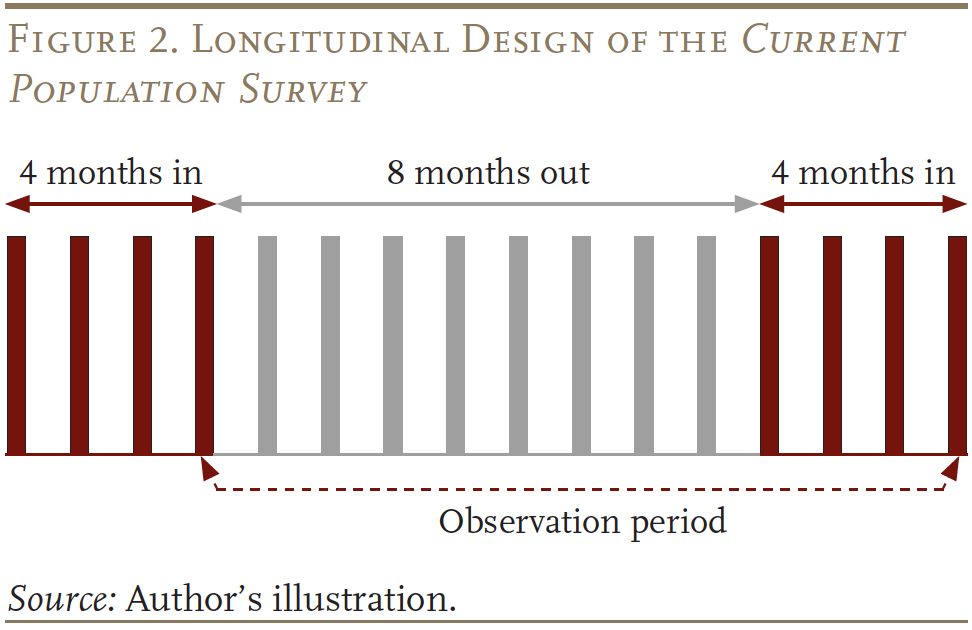
Has Remote Work Extended Workers’ Careers?
The brief’s key findings are:
- Previous research suggests that remote work boosts employment for older workers with disabilities, but how will it affect those without disabilities?
- The greater flexibility of remote work could lead people to work longer. Or, if employers think it reduces productivity, it could instead lead to earlier exits.
- This study finds that those working remotely appear somewhat less likely to retire, even controlling for job characteristics like sector, industry, and earnings.
- An open question is whether this beneficial effect is due to remote work itself or the fact that those wanting longer careers go to jobs with remote options.
Introduction
For many, the shift from five days a week in the office to at least some amount of work at home seems to be a lasting effect of the pandemic. Recent research suggests that this shift has helped late-career workers with disabilities, encouraging higher rates of employment than before the pandemic.1 But, remote work could affect older workers without disabilities too. The flexibility and ease of commute offered by remote work could encourage late-career individuals to work longer and delay retirement. Or, employers could view their remote workers’ productivity negatively, ushering in a quicker exit from the labor market.
Given the importance of working longer to retirement security, this brief explores which of these possibilities plays out using questions on remote work recently added to the Current Population Survey. The discussion is organized as follows. The first section provides background on remote work and its possible connection to retirement timing. The second section introduces the data and methodology, and the third section presents the results. The final section concludes that those working remotely appear somewhat less likely to retire than those who do not, even controlling for job characteristics like sector, industry, and earnings.
Background
Prior to the pandemic, remote work was uncommon. In 2019, only 6 to 8 percent of all workdays were done remotely. That rate more than tripled at the beginning of 2020 with the onset of the pandemic. And despite a somewhat steep decline towards the end of 2021, the share of days working remotely has remained at over twice the pre-pandemic rate.2
To date, most of the research on remote work and retirement has focused on workers with a disability. This focus was spurred by two observations. First, during the pandemic, the employment-to-population ratio of individuals with a disability hit a multi-decade high.3 Second, workers with a disability saw a larger increase in remote work during the pandemic than their counterparts without a disability.4 One study found that, in the years following the pandemic, remote work increased the employment rate of older workers with a disability by 10 percent – even controlling for the post-pandemic tight labor market and other factors.5
The question remains, however, how remote work affected other workers approaching retirement. On the one hand, some studies have found that remote work increases job satisfaction and reduces turnover, suggesting it might encourage people to work longer.6 Remote work could also be part of a phased retirement plan, whereby workers acquire more flexibility, but sacrifice pay and responsibility, making them willing to extend their career.7
On the other hand, it remains unclear how employers view remote work. Although much of the evidence on the impact of remote work on productivity is positive, limited evidence exists that in some industries the effect may be the opposite.8 And, in any case, employers’ perception of remote work varies considerably, with some viewing it negatively – especially along dimensions of innovation and creativity.9 To the extent that remote work actually reduces some workers’ productivity or even carries that perception, working remotely could result in some older workers being ushered towards retirement. Given the lack of clarity on remote work’s effect, this brief examines remote work’s impact on retirement timing for workers without a disability.
Data and Methodology
This analysis is based on data from the Current Population Survey’s (CPS) Basic Monthly questionnaire, which the U.S. Bureau of Labor Statistics uses to estimate monthly unemployment. The CPS added questions on remote work in October 2022 and has included these new questions in the survey since then. Figure 1 shows the share working remotely at least one day per week among employed people ages 55+ without any physical, cognitive, or sensory difficulties.10 The number has hovered between 15 and 24 percent from October 2022 through February 2025.

The question is whether these workers who work remotely at least one day per week retire more or less quickly than others. To answer this question, the approach relies on the panel nature of the monthly CPS. Specifically, respondents are surveyed in each of four consecutive months; then are out of the sample for eight months; and then re-enter the sample for another four months.
The analysis looks at how the labor force status of those ages 55+ changed between their fourth month in the survey and their last month in the survey (see Figure 2). That is, was a person working in the fourth month still working in the final month or had they retired? The last group of workers considered in this analysis was surveyed about their remote work in February 2024, with their retirement status checked in February 2025. Over the entire period considered, 7.1 percent of those working remotely were retired the following year, versus 9.0 percent of those who were not.

So, at first glance it seems remote work is associated with slightly longer work lives, but people who work remotely differ considerably from those who do not along several dimensions (see Table 1). In particular, remote workers are much more likely to be college educated, earn substantially more per week, and are less likely to work in physical industries. To the extent that all of these characteristics are associated with longer careers, failure to control for them would overstate the reduction in retirement associated with remote work. Of course, other characteristics that we cannot control for could also play a role. For example, if older workers who always planned to extend their work lives select remote jobs as the easiest way to do so, then the impact of remote work on retirement would be overstated.

To account for these factors, a regression analysis is run to compare otherwise similar people who happen to differ in their remote work status. The regression analysis controls for the demographic, familial, and job-related characteristics described above. The regression estimated is:
Probability of retiring = f (remote work, age, education, race, family, job)
Results
The regression results are shown in Figure 3.11 The main takeaway is that even controlling for demographic, familial, and job characteristics, remote work is associated with a statistically significant reduction in the probability of retirement. A person working remotely is 1.4 percentage points less likely to retire than an otherwise similar individual. Given that in this sample 9.0 percent of non-remote workers retire by the next year, this reduction represents a decrease of 14.4 percent (1.4/9.0).12 This reduction reflects two possibilities. The first is that the nature of remote work allows longer careers – a causal impact. The second is that workers who want to work longer choose remote jobs, which allow them to extend their careers more easily. Which of these two is driving the effect speaks to whether making it easier for additional workers to work remotely would extend their careers. Addressing this issue is a useful area for future research.

Consistent with many prior studies, job characteristics aside from remote work also seem to have statistically significant effects on retirement timing. The results suggest a doubling of earnings reduces the probability of retirement by 1.1 percentage points, whereby public sector work and part-time work are associated with increases in the probability of retirement by 1.2 and 4.2 percentage points, respectively. Family also seems to matter, with the presence of dependent children reducing the probability of retirement, likely due to financial constraints. Having a spouse who is retired has a predictably large effect – 4.1 percentage points – towards a more likely retirement. Race, ethnicity, and education were all statistically insignificant.
Conclusion
Remote work remains elevated relative to pre-pandemic levels and, for at least some workers, appears to be here to stay. Given the lack of savings of many Americans, so too is the need to work longer. The good news from this brief then is that remote work seems to facilitate, not impede, longer careers. Workers without disabilities who work remotely are 1.4 percentage points less likely to retire within a year relative to an otherwise similar counterpart. Future research should focus on whether this result reflects aspects of remote work that improve career longevity or instead the fact that those desiring longer careers select into these sorts of jobs. The question is important, as it speaks to whether offering remote work options is a way to simultaneously extend careers.
References
Barrero, Jose Maria, Nicholas Bloom, and Steven J. Davis. 2023. “The Evolution of Work from Home.” Journal of Economic Perspectives 37(4): 23-49.
Bloom, Nicholas, Ruobing Han, and James Liang. 2024. “Hybrid Working from Home Improves Retention without Damaging Performance.” Nature 630(8018): 920-925.
Bloom, Nicholas, James Liang, John Roberts, and Zhichun Jenny Ying. 2015. “Does Working from Home Work? Evidence from a Chinese Experiment.” The Quarterly Journal of Economics 130(1): 165-218.
Carr, Dawn C., Christina Matz, Miles G. Taylor, and Ernest Gonzales. 2021. “Retirement Transitions in the United States: Patterns and Pathways from Full-time Work.” Public Policy & Aging Report 31(3): 71-77.
Choudhury, Prithwiraj, Tarun Khanna, Christos A. Makridis, and Kyle Schirmann. 2024. “Is Hybrid Work the Best of Both Worlds? Evidence from a Field Experiment.” Review of Economics and Statistics: 1-24.
Emanuel, Natalia and Emma Harrington. 2024. “Working Remotely? Selection, Treatment, and the Market for Remote Work.” American Economic Journal: Applied Economics 16(4): 528-559.
IPUMS USA. 2025. IPUMS CPS: Version 12.0 [dataset]. Minneapolis, MN: University of Minnesota.
Kessler Foundation. 2022. “June 2022 Jobs Report: Employment Reaches All-time High for People with Disabilities.” National Trends in Disability Employment Report. East Hanover, NJ.
Liu, Siyan and Laura D. Quinby. 2024. “Has Remote Work Improved Employment Outcomes for Older People with Disabilities?” Working Paper 2024-12. Chestnut Hill, MA: Center for Retirement Research at Boston College.
Marks, Cassandra and Hannah Rubinton. 2024. “The Labor Effects of Work from Home on Workers with a Disability.” On the Economy Blog. St. Louis, MO: Federal Reserve Bank of St. Louis.
Pabilonia, Sabrina W. and Jill J. Redmond. 2024. “The Rise in Remote Work Since the Pandemic and its Impact on Productivity.” Beyond the Numbers 13(8). Washington, DC: U.S. Bureau of Labor Statistics.
Tahlyan, Divyakant, Hani Mahmassani, Amanda Stathopoulos, Maher Said, Susan Shaheen, Joan Walker, and Breton Johnson. 2024. “In-Person, Hybrid or Remote? Employers’ Perspectives on the Future of Work Post-Pandemic.” Transportation Research Part A: Policy and Practice 190: 104273.
U.S. Census Bureau. Current Population Survey, 2022-2025. Washington, DC: U.S. Government Printing Office.
Appendix

Endnotes
- See Liu and Quinby (2024). ↩︎
- See Barrero, Bloom, and Davis (2023) and Liu and Quinby (2024). ↩︎
- See Kessler Foundation (2022). ↩︎
- See Marks and Rubinton (2024). ↩︎
- Liu and Quinby (2024). ↩︎
- See Bloom, Han, and Liang (2024). ↩︎
- See Carr et al. (2021) for a discussion of how remote work may fit into these transitions. ↩︎
- For evidence that remote work can lead to positive effects on productivity, see Bloom et al. (2015) or Chowdhury (2024), for example. For evidence that the effect of remote work on productivity differs considerably across industries, with some potentially negatively affected, see Pabilonia and Redmond (2024). For a study showing negative productivity at a single firm, see Emmanuel and Harrington (2024). ↩︎
- See Tahlyan et al. (2024) for a discussion of employer perceptions of remote work, with evidence of considerable variance in perceptions. ↩︎
- The monthly CPS does not ask specifically about disabilities, but instead whether the individual has any difficulty walking or climbing stairs, moving outside the home, with vision, with hearing, with memory, or with caring for themselves. People who answered “yes” to any of these difficulties were removed from the sample. ↩︎
- Results shown are the average marginal effects from a Probit regression. Full results with standard errors are included in the Appendix. ↩︎
- This calculation was performed by calculating the odds of retirement at each age for each non-remote working member of the sample. This number was then reduced by 14.4 percent, and the odds of “surviving” to work at each age calculated. Given this survival curve, an average age of retirement was calculated for the original odds and the reduced, “remote work” odds. ↩︎








